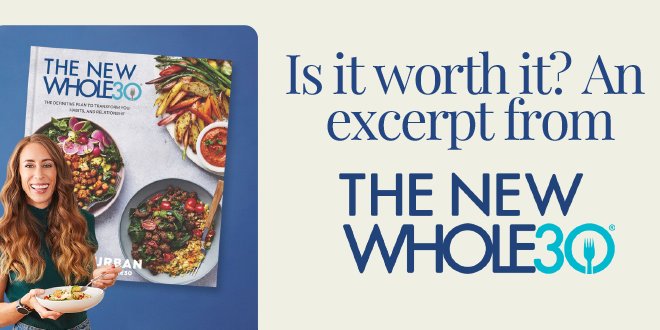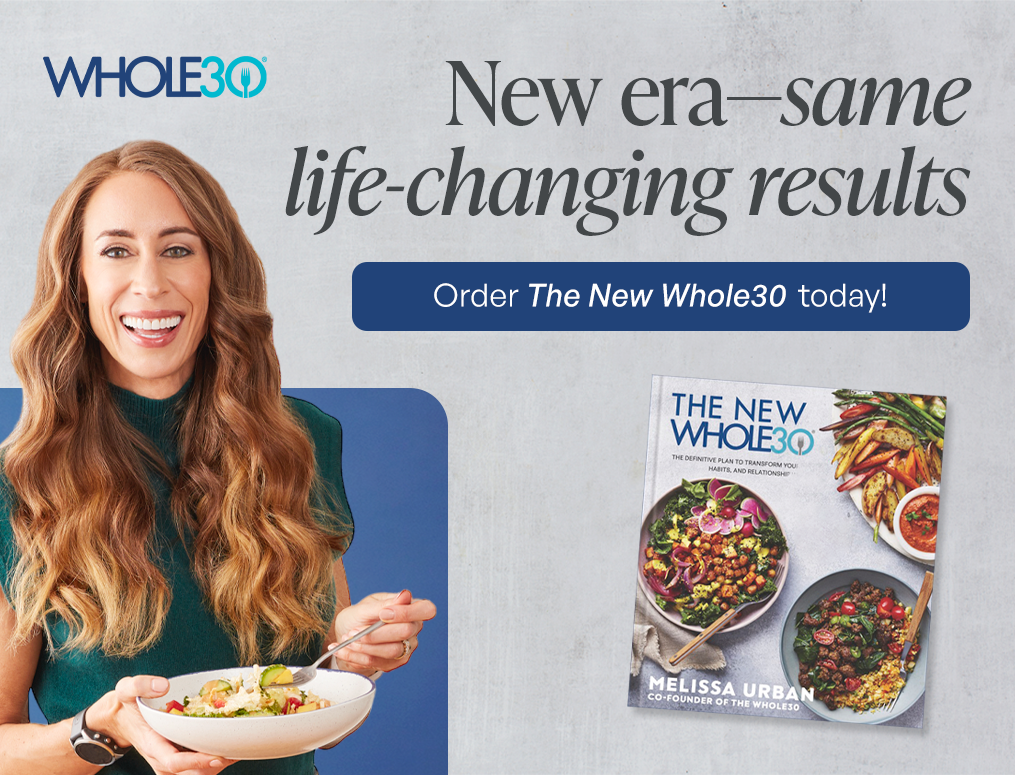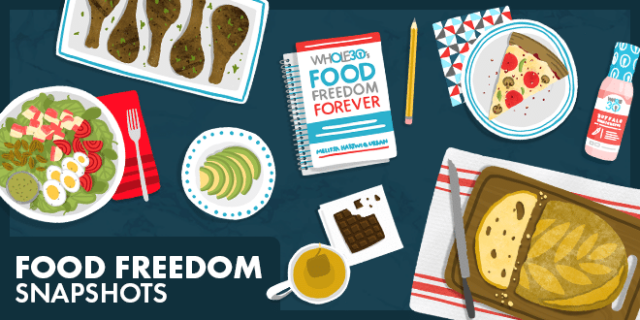So often, people think of the Whole30 only as elimination and reintroduction. As if once you complete those two phases, we send you off with a graduation certificate, bragging rights, and a wheelbarrow full of non-scale victories (NSVs). Which you will, and that is awesome—but your time with us is not over yet.
Completing the program isn’t the end of your Whole30 journey. In fact, elimination and reintroduction are just stepping stones to the real end-game… a lifetime of true food freedom.
What is food freedom?
From our updated flagship book, The New Whole30 (2024):
What happens after the Whole30 is over? Quick-fix weight loss diets send you off into the sunset (may the odds be ever in your favor), providing no further guidance on how to take the program and turn it into a sustainable, healthy lifestyle. Spoiler alert: That’s because you can’t. Those weight loss diets aren’t designed to change your habits or emotional relationship with food, even if they claim to. They’re not even designed to improve your health! They exist only to make you smaller, with unsustainable crash-diet tactics that “work” only in the short term, if at all.
The Whole30 isn’t that. With our program, you will discover that the lessons you learn through elimination and reintroduction will become the foundation for a long-term, gratifying, healthy (as you define it) diet. Hallelujah!
Food freedom is the final stop on your Whole30 journey. This phase is where you use the information you’ve learned from elimination and reintroduction to create your own personalized, sustainable, joyful diet. After your Whole30, you know better than any diet trend, new study, or magazine article the foods that work best for you—and the foods that don’t.
Much like your Whole30 journey, your Food Freedom plan will be one of a kind, shaped by:
- Your uniquely personal reasons for starting the Whole30
- The lessons you took from the experience
- The observations you made about how foods and food groups work in your unique body
- Your collection of Non-Scale Victories
Food freedom is feeling empowered to choose the foods that feel right for your body, and trusting yourself to make those choices.
Your food freedom is waiting for you on the other side of your Whole30 elimination and reintroduction–but it doesn’t just happen. Using your Whole30 learnings, you’ll create your own unique Food Freedom plan to help you make future choices around food and alcohol. And as with your elimination and reintroduction, we give you a structured approach and best practices here, too.
Your food freedom is based on one foundational question: Is it worth it?
Is it Worth It?
A good Food Freedom plan starts with your own personal decisions about “worth it” foods and drinks. From Whole30 CEO Melissa Urban in The New Whole30:
Based on your Whole30 experience, you’ll know how eliminating and reintroducing those foods impacts your energy, sleep, cravings, mood, digestion, pain, inflammation, and other symptoms. Asking “Is it worth it?” helps you evaluate the known consequences of eating this food against the satisfaction, sense of belonging, or pure pleasure of eating it. (As an example), gluten leaves me with bloating and breakouts. The question, “Is it worth it?” helps me easily pass on the leftover break-room donuts at work, but enthusiastically enjoy my mom’s freshly baked rolls at Thanksgiving.
Only you know how to answer that question for yourself, and your “Is it worth it?” barometer will change given your health, your goals, and the context of the food in question. (Ice cream might be worth it on a summer afternoon while on vacation with your family, but not at 10 p.m. on a random Sunday night.)
The key to “worth it” is that you have to decide this for yourself—we can’t do it for you. That’s actually the point, because someone else making decisions for you isn’t exactly “freedom.” Take those break room donuts that, thanks to reintroduction, you know will tank your energy and give you cravings for the rest of the day. Is it worth it? Maybe it is, because you love donuts that much, or these donuts are really special. If it is, say yes, enjoy the heck out of them, and deal with the consequences.
If you decide it’s not worth it (you have a big meeting after lunch, you have a date later that night, or you don’t want to battle your willpower for the rest of the day), then it’s easy to decline. In your food freedom, there is no food off limits and no sense of deprivation, because you are always in charge of deciding what’s best for you.
Say yes with confidence
In your Whole30 reintroduction, you may have been highly focused on the negative impacts these food groups brought to your physical and mental health. However, the Whole30 is just as much about identifying the foods that do work well for you as those that do not.
In the same way, food freedom isn’t about always saying no. In your food freedom, you’ll also learn to say a confident yes to whatever you decide is worth it. Your “Yes List” may include some, most, or all of the Whole30 elimination groups! You may discover that gluten works well for you, and sourdough becomes your breakfast BFF. Or you may decide that some bloating or joint pain is totally worth the joy of eating your favorite ice cream.
What’s important is that your elimination and reintroduction experience—not someone else’s food rules—inform your choices going forward. In your food freedom, you can trust yourself to answer “Is it worth it?” in the way that feels the best to you. Not bad for a month and a half of work, right?
Resources for your Food Freedom plan
Read (or listen to) these resources to learn more about life after the Whole30, and how to create, work, and refine your own personalized Food Freedom plan.
- Our newest release, The New Whole30, offers the most up-to-date information, guidance, and recommendations for your Whole30 elimination, reintroduction, and Food Freedom plan. Start here!
- The 2016 book Food Freedom Forever (available in paperback, ebook, and audiobook) is a comprehensive, dedicated resource for crafting and executing your Food Freedom plan. This is a great book to read or listen to during reintroduction, to prepare you for this next Whole30 phase.
- View the Food Freedom hub on our website for more articles to support your food freedom journey.
Disclaimer: This page contains affiliate links. We earn a small commission when you purchase through these links.

















